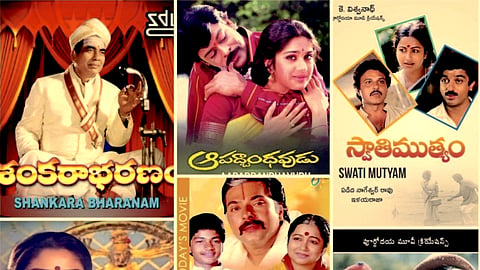- Commentary
- History Vignettes
- Notes on Culture
- Dispatches
- Podcasts
- Indian LanguagesIndian Languages
- Support

"I OFFER A HUNDRED THOUSAND SALUTATIONS to the donor who extended his hands to guard the flame of pure, traditional classical music, fluttering under the assault of the tornado of Western music," says a deeply emotional Shankara Sastri, moments before he begins the final concert of his life.
That is the final scene of Kasinathuni Viswanath’s landmark classic, Sankarabharanam. It is also one of the most powerful climaxes in Indian cinema, deriving its power from the subtlety of emotion it evokes within us.
Sankarabharanam also heralded an unprecedented artistic departure and marked a fresh beginning in K. Viswanath’s prolific cinematic career lasting more than five decades. Until Sankarabharanam, Viswanath had only made social movies debuting with the 1965 superhit Atma Gowravam. With Sankarabharanam, he had pleasantly stunned the nation with a musical and cultural triumph on celluloid.
Few movies have delivered such widespread cultural and social impact as Sankarabharanam when we consider the fact that almost every scene, song, and dialogue became a staple household diet in South Indian homes. In an era when the phrase “pan Indian film” is being tossed around with thoughtless and fact-free impunity, it is opportune to remind such folks that Sankarabharanam arguably remains one of the finest pan-Indian movies. The lyrics of the movie’s opening song, Omkara naadanu sandhanam… was retained as is when it was dubbed in Malayalam with zero loss in translation and audience appreciation. In fact, Sankarabharanam’s success in Kerala almost rivalled its blockbuster status in Telugu.
Almost overnight, the film reopened the eyes of Indians to the greatness of their own classical musical heritage. In the realm of art, great exaggerations contain abiding truths in their womb. Kumbhakarna’s bi-annual ritual of waking up counts as one such exaggeration. Likewise, Sankarabharanam awakened the masses – especially in South India – from their cultural slumber. A real-life consequence of this awakening was the immediate spike in the number of people enrolling for classical music lessons.
Students specifically requested their Gurus to teach traditional compositions used in the film: Brochevarevarura (composed by Mysore Vasudevacharya), Samaja Varagamana (Tyagaraja), and Manasa Sancharare (Sadasiva Brahmendra).
When the film's crew toured (undivided) Andhra Pradesh after it completed the 100-day run, J.V. Somayajulu (who played the protagonist Shankara Sastri) had to pay special attention to his attire and demeanour in public. The public had elevated him to the status of a saint. It is said that he met with popular disapproval when he was seen wearing western attire. It was fatal if he was ever caught smoking. The reel had become more real than reality. The late S.P. Balasubramaniam has narrated an earnest anecdote about the imprint that Sankarabharanam made on Somayajulu, the actor and the person. After a screening in Delhi, the projector-operator, a burly Sikh gentleman, held Somayajulu’s wrist and said in a commanding tone, “please touch the projector and sanctify it.” The operator’s eyes had welled up.
This impact is profoundly different from the brute-level impact that Sholay has left behind. Movies like Sholay and Deewaar have disfigured at least two generations. And this impact of Sankarabharanam is rarely, if ever, mentioned in the annals of film critiques.
No other movie that Viswanath made after Sankarabharanam was able to attain the same iconic status of a cultural landmark.
Any appreciation of K. Viswanath’s cinematic craft and artistry must begin with Sankarabharanam.
But to restate the basics, there is a clear contrast between “appreciation” and “criticism.” This is because the dominant “school” of literary and art criticism decrees that appreciation is a sin. However, we stubbornly adhere to the time-honoured tenets of Indian aesthetics. One of its central tenets states that any analysis of a work of art should be done from the vantage of a Sahrudaya, a genuine connoisseur who seeks to appreciate art as a unified experience rather than picking holes using extraneous theories unrelated to aesthetics.
With regard to Viswanath’s films, the aesthetic element is spread over and harmonized in numerous layers of plot, dialogue, lyric, music, dance, and scenes. It is thus a challenge to analyze his repertoire using an isolationist approach. While the analysis can be done using one or more of these elements, it yields partial fruit.
From this perspective, this essay series attempts to chart a different course. Of treating Viswanath’s artistic legacy as Bharatiya cinema – a fundamental differentiator from the obscenity known as “pan-Indian cinema.” The simplest definition of Bharatiya cinema is cinema in which art itself is the language.
We can examine this legacy by breaking it down into four major constituents: (1) The country (Rashtra) (2) The society (Samaja) (3) The individual (Vyakti) (4) The overall artistic approach of Kasinadhuni Viswanath.
To be continued
The Dharma Dispatch is now available on Telegram! For original and insightful narratives on Indian Culture and History, subscribe to us on Telegram.
